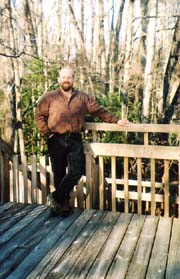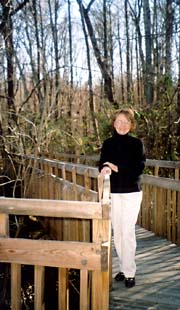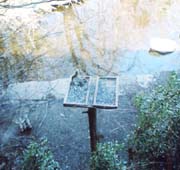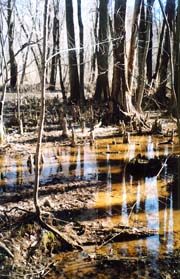
|
 |
|||||||||||||||||||||||||||||||
|
||||||||||||||||||||||||||||||||
|
Swamped The Lure of the Swamp
|
To visit the Battle Creek Swamp Sanctuary, follow Route 2-4 south of Prince Fredrick to Sixes Road, Route 506. Turn left on Grays Road and travel one-tenth mile to the Swamp Sanctuary on the right. Open 10am-4:30pm Tuesday-Saturday,1-4:30pm Sunday: 410-535-5327. |
ing swamp. I inhale the sweet, fresh smell.
Less than a month ago, when the fields were taupe and brown, the swamp looked different. The crystal-clear water that floods it late in winter was an inch or two higher on the clean bottom the color of terra cotta. Two red-shouldered hawks circled high in the improbable cerulean sky. A single unseen bird accompanied me on my walk, singing her heart out somewhere high in the cypress tree.
Walk on the Wild Side
It’s such a brief walk on the Battle Creek Cypress Swamp boardwalk that it must be made slowly, to savor this time before the swamp’s full awakening.
The majestic bald cypresses are just beginning to throw off their winter sleep. The delicate pale green needles are nowhere to be seen. Instead I enjoy phantasmagoric cypress shapes reaching into a sky exposed without summer’s canopy of green.
Unlike the familiar evergreen cypress, the bald cypress, Taxodium distichal, sheds its delicate, pale-green needles in the fall. Huge, fuzzy ropes climb the height of the cypress. Ah, yes, the scourge of the swamp, poison ivy, thrives here. The thick bases of the cypress are surrounded by gnome-like protuberances, knees that help stabilize the tall trees in an uncertain terrain and that bring oxygen to the roots. A touch of green here and there colors this sere landscape: holly, some early grasses. Is that Virginia creeper over there?
On this March weekday, I have not run into another person in the swamp. It’s just me and my camera. My solitude is complete. No, not really. I hear little creatures scurrying in the dry brush. A snake? A rabbit? Perhaps a raccoon? I’m excited at sharing this magnificent kingdom of nature with the swamp’s rightful owners.
The wind picks up, tearing at the tops of the tall trees, ripping off small branches. Uneasily, I notice a fallen cypress and a maple tree resting in the clear water. The dry branches crunch under my feet. The peepers have stopped their love song.
The Man of the Swamp
 |
photo by by Helena Mann-Melnitchenko
|
A sturdy bearded man in a plaid shirt and bo
ots crosses my path. He looks like a woodsman who belongs here.
The woodsman turns out to be Andy Brown, Calvert County’s senior naturalist. He holds a degree in wildlife management and has worked with Calvert Natural Resources for 19 years. He’s a font of information.
The first thing he wants me to know is that the mission of his division is environmental education, both to the public and to the county schools.
“Calvert County has taken the Chesapeake Bay Initiative and run with it,” he says. The teacher in me fills with pleasure.
But it’s the swamp I want to know about.
The 75- to 100-year-old cypress trees stand with their thick bases in a place where pollen grains, recovered from the depths of the creek, date to 400bc.
Bald cypress trees can live almost a millennium.
These are not so old. Battle Creek cypresses are relatively young trees, given away by crowns shaped like an inverted pyramid.
“Repeated logging over time, and as recently as the mid-1940s,” Brown says, “destroyed the ancient trees.”
In larger, deeper swamps farther south, swamps that had partially escaped logging, I have seen the flat tops of ancient cypress.
In a swamp, even fallen trees are islands of life.
“As the maple trees fall over, exposing their large root ball, these mounds erode and create a small island-like feature call a hummock,” Brown explains. “They’re very important ecological features. Many plants germinate here and many wildlife species use them for nesting and finding food.”
Life from death. I wonder if that’s what was behind Oates’ image of a place that smells of sweetness and rot.
“Does the swamp smell bad in any season?” I wonder.
“A common misconception,” Brown replies. “The water moves through the swamp and rarely becomes stagnant. When the lizard-tail blooms the first week in July, it is very fragrant.”
I make a mental note to visit the swamp at that time. Then I think of mosquitoes.
 |
About the AuthorHelena Mann-Melnitchenko of Owings is a regular contributor to Bay Weekly. Her last feature, on December 22, 2005 [Vol. xiii, No. 51] was The Girl Who Forgot Christmas. |
“Will there be mosquitoes?” I ask.
The moving water of Battle Creek does not allow their breeding, Brown explains, so the swamp is mostly mosquito free.
All the more reason to visit the swamp in the summer.
I wonder if the swamp once sheltered the southern Civil War hero, the Swamp Fox. Probably not, he operated in the deeper swamps of Virginia and the Carolinas.
A Creek Runs Through It
In this swamp, despite its name, no battles were fought.
I trace its name as I drive out to Sixes Road, crossing a bridge over a creek going its serpentine way to join Patuxent River at a place where the county seat once stood — and, from time to time, the early colony’s council of state convened.
Battle Town was named for a town in England, where the battle of Hastings was fought in 1066. Once navigable even to schooners, Battle Creek took its name from the flourishing town. The tidal creek provided transportation for the area, and local Indians used the hardwood for their dugout canoes. Battle Creek gave power to the saw and grist mills for milling wheat and corn.
I can’t help but reflect on how rich Maryland is in its waterways. The Eastern Shore boasts the marshes that James Michener called a “mysterious hiding place in which water and land competed.” The Western Shore has this ancient swamp, albeit — as are Michener’s marshes — much reduced.
Go Out of Your Mind in the Swamp
The swamp is one of those places you either get or you don’t. You love it or you hate it.
by Joany Nazdin
I’ve just lost my mind in the swamp. It was a great experience.
Sitting in the Nature Center of the Battle Creek Swamp Sanctuary, I felt all my troubles float away. Careless, I entered that peaceful space continually more difficult to find in this hectic life.
On a seat that perched me at the l
 |
|
photos by by Joany Nazdin |
evel of a very busy bird feeder, I joined the flock of birds outside, soothed by the flitting of the finches and cardinals. I must have taken on the glazed look of a woman who has eaten one too many Xanax.
Smiling ear to ear, I saw a squirrel fling itself from a tree six feet away to land dead center on the bird feeder, reinforcing my theory that there is no such thing as a squirrel-proof bird feeder.
A few feet from the feeder, a waterfall fed a pond. The sound of the running water and the image of the waterfall made for a first-class meditative arena.
Moving my gaze upward, I saw a canopy of native foliage that would be beautiful in any season. This place has more to offer than meets the casual eye.
Sanctuary in the Swamp
Calvert County’s Battle Creek Cypress Swamp Sanctuary was founded to save the northern-most stands of bald cypress trees in the United States. The Nature Conservancy acquired the 100-acre parcel in 1957 to protect its unique stand of bald cypress trees.
Cypresses grow as tall as 100 feet. Their green leaves turn to a soft brown or orange in the fall. Year-round, their bark is reddish-brown. At their base a trademark set of cypress knees helps stabilize the trees in muddy soil. The mature cypress tree secretes a chemical called cypressene that makes it resistant to decay and valuable to boat builders.
As well as home to a forest that likes wet feet, the swamp is also rumored to have been a hiding ground for escaped slaves and criminals on the run. Two abandoned stills from the 1930s, one destroyed by dynamite, were found on the grounds when the land became a park. Today the swamp is home to such animal desperados as beaver, skunk, raccoon, river otters and foxes.
On e of those creatures lives in a large cage right beside the entrance to the Nature Center. A large, wise looking, blind owl, he was brought to the sanctuary after being hit by a car. He makes up for his lack of sight by sharpening his other senses. Now he tracks his visitors by sound, his head constantly moving.
e of those creatures lives in a large cage right beside the entrance to the Nature Center. A large, wise looking, blind owl, he was brought to the sanctuary after being hit by a car. He makes up for his lack of sight by sharpening his other senses. Now he tracks his visitors by sound, his head constantly moving.
The naturalist who feeds the owl his daily plump mice and fuzzy chicks says that he can pick her footsteps out of a crowd of 25 schoolchildren and flutters to the side of his cage when she hand-feeds him his daily morsels.
The owl is not the only animal that has drawn the short stick in its encounters with humankind. As humans arrived in greater numbers, many species have vanished. Black bear lived in Calvert County as late as 1634, and rattlesnakes as late as 1698. A bobcat was last reported in Southern Maryland in 1945. In 1975 a species of tiger salamander became extinct, with the last known sighting reported in Port Tobacco.
Children, too, find refuge here. On many days, children’s programs are scheduled.
On the day that I visited, Susan Mandile of Chesapeake Beach brought her two children, Andrew, five, and Susan, three.
“The kids love it here,” Mandile said. “We like to bring them about every two months to walk on the cypress trails. We had the best time when they did the Up the Creek program last summer. Everybody was in the creek up to their waists with nets catching frogs and fish.”
For Love of the Swamp
The Nature Center features exhibits about park wildlife on its first floor. One of the exhibits brings up the mystery of the place, recalling tales of secret meetings and livestock happy to return home after being lost in the swamp. Ponder why you came here, the exhibit asks.
I concluded that the swamp is one of those places you either get or you don’t. You love it or you hate it. When I show my pictures to people that I work with, reactions range from Such a beautiful bird! You could sell that picture on eBay to Oh no! You didn’t go walking around in that!
The second floor of the nature center is where most of the wild things are. Here you might be lucky enough to meet R. Lloyd Hepburn, who’s volunteered at the park for 25 years. A retired schoolteacher, Hepburn has seen his old students return as parent-chaperones from the many school groups that visit.
If you meet him, he’s sure to show you his reptile and insect collection, perhaps even the rarest snake in Southern Maryland, the mole king snake.
“We are very lucky to have this snake,” said Hepburn. “If you were to go search for one, it would be like finding a needle in a haystack.”
Hepburn was comparing the sizes of one-year-old and five-year-old black rat snakes when the juvenile coiled up and struck his hand. Hepburn never missed a beat in his explanation of the rapid growth of the snake.
Later, Hepburn shrugged off the bite.
“The black rat snake is very territorial,” he said. “Since this one is only about a foot long, it didn’t hurt when he bit me. Now if the four-foot-long, five-year-old had bit me, it might have been different.”
 |
About the AuthorJoany Nazdin, a registered nurse, lives in St. Mary’s County. This is her debut as a writer. |
Closing Encounters
After you tour the nature center, be sure to take a stroll through the swamp. Walking along a quarter-mile raised boardwalk, you’ll see the beauty of the swamp without getting your feet wet.
As I was strolling near the Nature Center, a small boy came up to me.
“Come look,” he said.
I followed him inside to a large terrarium where an albino snapping turtle lived, one of only eight known to exist in the world. The turtle was floating in the water like a pale ghost. My last impression of the Nature Center was of a young boy and a turtle, pressed nose to snout through the glass.

